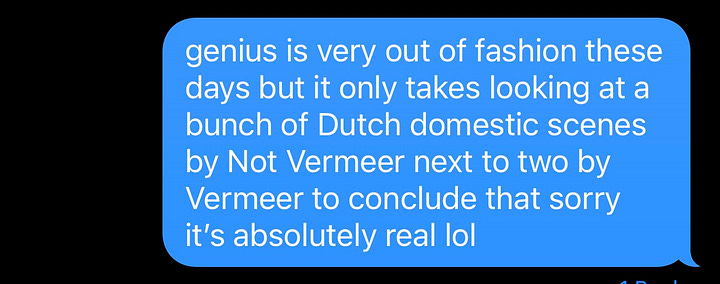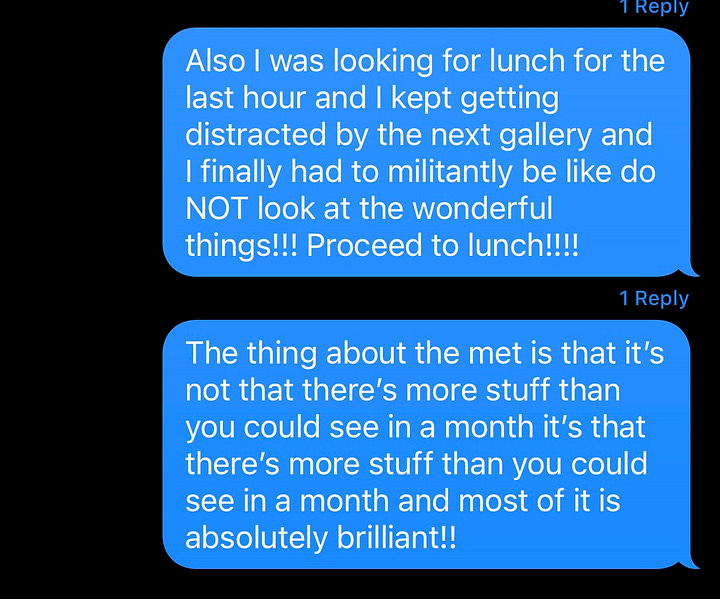Peter Schjeldahl, Dave Hickey, Poptimism’s necessary counterpart
how to learn to like paintings
Back in the saddle again! I stopped going to art museums for a while bc of general life changes so I don’t know what form the writing here will take (and it will continue to be extremely irregular) but I started writing this as a comment that got verbose enough that I figured what the hell, why not blow the dust off the newsletter proper.
Last night I was finishing up the
podcast on Dave Hickey and opened this app to see that had also written a bit about it, which led me to some discussion in the Notes section about Hickey’s purported poptimism. Hickey was known for his defenses of low culture and kitsch, for his great essays in Air Guitar on Liberace, Las Vegas, and Siegfried and Roy. Read uncharitably or with hostility, Hickey could be seen as laying the groundwork for vulgar poptimism, the kind that insists that everything is just as good as everything else and no one actually likes anything challenging - they’re lying to themselves, or to you.1
This got me to thinking about Peter Schjeldahl, the longtime New Yorker art critic, one of the inspirations for this substack and perhaps my favorite prose stylist of all time.1 Aside from being friends with Hickey (at least in public life, perhaps as similar critics they had a private rivalry) they share a brash American populism, a conversational and easy way of writing indebted to the American tradition of Whitman, Melville, and Twain, as if the whole world were bright and exciting and in front of them for the taking.2 But Schjeldahl feels like a reverse poptimist in that when I read him I find myself thinking, it’s completely right and normal to be deeply moved by some seemingly forbidding painter. Not to merely “appreciate” or “contextualize” art but to have an extremely potent emotional reaction.
Here’s how he describes Mondrian, that most theoretical of high modernists:
Look hard. That's how to love Mondrian. It's a dumb tack to take with most painting: to stare, to pitch into with your gaze, to burn holes in like a rube or a humorless child. Normal painting involves learned conventions. Not Mondrian. I promise you stabs of delight if you can gawk stupidly enough at the classical pictures, from the two decades before his death in 1944. The earlier work is great, too, but yields itself to regular looking.
I stumbled on the trick as a youth desperate to understand modern art. Most of what I saw in museums wouldn't play with me. I didn't know enough yet. I couldn't sort out the unusual from the usual. But looking at Mondrians was like throwing myself off a cliff and being caught by a trampoline. It made me high. It still does, to my surprise. I had forgotten. I went to this tidy retrospective feeling bored with the modernist canon. But then there I was, reeling anew
The standard theories and explanations of modern art have become almost as embarrassing as Communism. Decades of cogitation about "abstraction" circle history's drain. Contemporary smarts hold that all possible pictures are both abstract and figurative, so never mind. Mondrian's writing palls, too. His early Theosophical mysticism and later Utopianism are alike in tedium-the mysticism slightly less so, because critics have been so unfair to it. (But Madame Blavatsky?!) As a result, people may feel that they've had enough of him when actually they've had very little. One problem is the work's ubiquity in reproduction, which gives not the slightest hint of its drama in person.
Mondrian's pictures are now about only the experience that they offer. To have it, I suggest first going through the show studiously. Read the damned wall texts, because who can not read writing on walls? (It's primordial, maybe dating from "Beware the Sabre-Toothed Tiger.") Register the boilerplate "march toward abstraction." Remind yourself that you don't care. Mondrian could have marched to Pretoria for all it mattered. (It matters as a difficulty that he incurred and that made him sweat.)
Then, after a stroll in MoMA's garden, return to stalk joy.
Maybe start at the end, with Broadway Boogie Woogie. You have seen this jigsaw of colored lines and little squares many times. It is always up at MoMA. Now look hard. It is three pictures in one, each starring a color: red, yellow, blue. When you think red, the other hues defer. They do a jiggling routine in praise of the hero, red. When you think blue, blue steps out, and red joins the chorus. Then yellow, the same. (A fourth color, gray, shyly holds to a supporting role.) It really is like boogie-woogie piano, ping-ponging between left and right hands. You could also take it as an allegory of democracy. Don't, though.

People talk about making the museum more accessible and cleansing art of the stain of pretension. How would they do that— more wall texts? Coloring activities for adults? No! You have to do what Schjeldahl did and communicate the experience OF looking at paintings. To make people understand WHY you might invest your time in these experiences. This is the bulwark against the vulgar form of poptimism that dominated online cultural criticism until recently.3 You have to describe the blooming, buzzing experience of coming into awareness with art and why it might be desirable, more desirable and fulfilling than things that are easier. And the people who want to chase that feeling will do so and the people who are content to stick to Netflix, well, their loss.4
It does take more work to like paintings than a pop song. It’s a process of learning to tune one’s awareness, of entering into a relationship both passive (open and receptive) and active (once received, processing and perhaps arguing) with the painting, of learning to really focus on one image in an age of extreme image saturation.
But this is what the vulgar form of poptimism misses and Schjeldahl knew: anyone can do it. Anyone can learn to cook if they put in the time, anyone can get strong if they go to the gym. I didn’t used to think much of paintings and I would go to art museums and leave bored and slightly confused. When I read Schjeldahl and Robert Hughes and John Berger and TJ Clark I was slowly taught this process of emotional reception and one day I went to a museum and I found that my entire way of perceiving paintings had changed and they all buzzed with life around me. It was like I could suddenly sit down at a piano and play a concerto. And you can teach yourself to like opera or read Joyce or any other snooty-coded thing if you put in a little time and effort. You might not have that much of a response to it, but you can understand it. Take notes, it helps. And go alone.




By the way, Schjeldahl died in 2022 and the New Yorker’s new art critic, Jackson Arn, seems to basically be doing a Schjeldahl tribute act? Here’s a paragraph from his review of the Met’s blockbuster Manet/Degas show:
The Louvre meeting, almost too perfect-sounding to be true, was nothing special by nineteenth-century Parisian standards. These guys all knew one another, not just the artists but the writers and the politicians. (Baudelaire, Mallarmé, and Zola make cameos in this show, as does Antonin Proust, Manet’s childhood friend and later France’s Minister of Fine Arts.) Both Degas and Manet came from posh families and bobbed on the same vast sea of connections. Degas, despite being something of a loner by temperament, as well as an enthusiastic critic of women and Jews, seems to have been incapable of not knowing everyone. When Manet’s brother married the Impressionist artist Berthe Morisot, Degas gave him a portrait as a wedding present; Manet’s son later worked for the Degas family. Degas painted Manet, too, and drew him looking dark-browed and bushy-bearded.
The forced “these guys,” the jokey “enthusiastic critic of women and Jews” aside — it’s all just so subtly slightly wrong. It completely clangs. I’m fascinated by it. They should teach this and Schjeldahl on Mondrian next to one another in freshman composition classes.
Obviously there are both exhilarating and troublesome implications to this very American state of mind.
I have to say, complaining about this already feels like a dead point. With Pitchfork’s impending demise and Twitter/X hollowing itself out that kind of late 2010s cultural criticism has finally sunk beneath the waves. More and more we’re withdrawing into our little communities— to Substack, to Discord, to private networks that take a little more work to find. Good! The cacophony where everyone had to listen to everyone else was a disaster. Better to put up some barriers so the would-be initiates have to do a bit of work.
There’s a great, inspiring book called The Intellectual Life of the British Working Classes, by Jonathan Rose. He goes through all these memoirs and diaries from the 17th-early 20th century and documents a lively and active intellectual life among people with much less formal education than anyone reading this. Welsh coal miners were forming Kant reading groups. Soldiers at the Somme were finding echoes of their experiences in Homer. Of course, not everyone was doing it, but many more people than you might think— many more people than the vulgar poptimist wants you to think!



This was so good!!! I wish I could adequately express how delighted I felt reading this—I also love Schjeldahl and feel that he (and writers with a similar gift for enthusiastic, inviting connoisseurship and appreciation) are really saving art and culture, in a way. That sounds very lofty and grandiose, but what I mean is: it matters a lot when a writer can show someone WHY they should love something, and invite people to have a personal relationship with great/exciting/ambitious/challenging work. Unfortunately, many people (I include my past self in this category) think that it’s the popular, consumable works that are the most fun, and great works are a chore to encounter. Schjeldahl’s great gift was showing people that the great works can also be, very genuinely, fun.
And I think you captured that so perfectly here: “Schjeldahl feels like a reverse poptimist in that when I read him I find myself thinking, it’s completely right and normal to be deeply moved by some seemingly forbidding painter. Not to merely ‘appreciate’ or ‘contextualize’ art but to have an extremely potent emotional reaction.”
revisiting this shortly after finishing Hot Cold Heavy Light (on Celine's recommendation of course)...I am so vindicated to hear the Jackson Arn critique somewhere other than my own brain